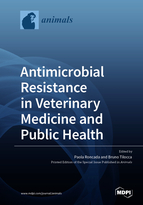Antimicrobial Resistance in Veterinary Medicine and Public Health
A special issue of Animals (ISSN 2076-2615). This special issue belongs to the section "Veterinary Clinical Studies".
Deadline for manuscript submissions: closed (31 March 2022) | Viewed by 32167
Special Issue Editors
Interests: proteomics; metabolomics; one health; microbiome; animal health; microbiology
Interests: animal infectious disease; microbiota; metaproteomics; antimicrobial resistance; diagnosis; prophylaxis; virus; fungi; bacteria
Special Issues, Collections and Topics in MDPI journals
Special Issue Information
Dear Colleagues,
The last decade has witnessed a tremendous increase in the onset and spread of antibiotic resistance by microorganisms of human, animal, and environmental concern and it is, today, representing one of the most important health-threatening issues worldwide. Antimicrobial resistance is the intrinsic capability of microorganisms to survive unfavorable conditions; such traits are mainly transferrable through mobilizable genetic elements, enabling the rapid and homogeneous diffusion over diverse ecosystems and sectors including human medicine, veterinary medicine, and the environment. In this view, the One Health approach allows for a comprehensive depiction of the mechanisms responsible for the onset and spread of antimicrobial resistance traits, as well as enables a clear definition of the dynamics occurring among microbial members harboring diverse ecological niches that favor the orthogonal diffusion of antibiotic resistance between apparently separate milieus. With the purpose of a massive divulgation between research groups and scientists, the current Special Issue welcomes original manuscripts addressing the heterogeneous aspects of antibiotic resistance; in particular, research involving innovative approaches and technologies that consider antimicrobial resistance in a One Health context is desired, although animal to human translational studies and those featuring zoonic agents are also of potential interest.
Prof. Paola Roncada
Dr. Bruno Tilocca
Guest Editors
Manuscript Submission Information
Manuscripts should be submitted online at www.mdpi.com by registering and logging in to this website. Once you are registered, click here to go to the submission form. Manuscripts can be submitted until the deadline. All submissions that pass pre-check are peer-reviewed. Accepted papers will be published continuously in the journal (as soon as accepted) and will be listed together on the special issue website. Research articles, review articles as well as short communications are invited. For planned papers, a title and short abstract (about 100 words) can be sent to the Editorial Office for announcement on this website.
Submitted manuscripts should not have been published previously, nor be under consideration for publication elsewhere (except conference proceedings papers). All manuscripts are thoroughly refereed through a single-blind peer-review process. A guide for authors and other relevant information for submission of manuscripts is available on the Instructions for Authors page. Animals is an international peer-reviewed open access semimonthly journal published by MDPI.
Please visit the Instructions for Authors page before submitting a manuscript. The Article Processing Charge (APC) for publication in this open access journal is 2400 CHF (Swiss Francs). Submitted papers should be well formatted and use good English. Authors may use MDPI's English editing service prior to publication or during author revisions.
Keywords
- antimicrobial resistance
- biofilm
- zoonosis
- animal infectious disease
- omics science
- pathogens
- drug resistance
- biological control
- foodborne zoonotic pathogens
- antibiotics








